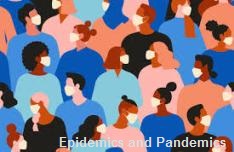
Vaccsbook

Infectious Diseases . . . and How to Avoid Them
Epidemics and Pandemics

This information is for entertainment purposes only. It has not been verified by a third party. Last updated: a while ago.
Epidemics
An epidemic has been defined in several ways.- More cases of a disease than usually occur in a particular place at a particular time,
- More cases of a condition than would normally be expected in a given population,
- A widespread occurrence of an infectious disease in a community at a particular time,
- A disease that spreads quickly and affects many individuals at the same time.
Examples of Epidemics are:
- Dengue Fever (2019-), in Latin America, with 2000 deaths.
- Measles (2019-) in the Democratic Republic of Congo, with over 6,000 deaths
- Cholera (2016-) in Yemen, with 4,000 deaths
- Polio (1916) in the USA, with 7000 deaths.
- Measles (1875-186) in Fiji, with 40,000 deaths, 1/3 of the population at the time.
- "Cocoliztli" (1545-1548) in Aztec Mexico, with 5 to 15 million deaths, 25% to 75% of the population, possibly due to Salmonella or a hemorrhagic virus.
Pandemics
A pandemic occurs when epidemics spread over many countries or continents.Examples of Pandemics are:
- SARS-CoV-2 (2020-), with over 3 million deaths and on-going
- Ebola (2013-2016), with 11,000 deaths
- MERS (2012-), with 800+ deaths and on-going
- "Swine flu" (2009-2010) with over 150,000 deaths
- SARS (2002-2004), with 700+ deaths
- HIV/AIDS (1981-) with over 30 million deaths, and ongoing
- "Spanish" flu (1918-1920), with 20-50 million deaths worldwide
- "Russian flu" (1889-1890, with 1 million deaths
- "Black Death" (1346-1353), with 75-200 million deaths, 30-60% of the population